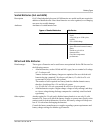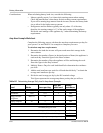
Battery Information
B–4 975-0012-01-02 Rev A
Understanding Battery Capacity Ratings
Discharge rate Deep cycle batteries have their amp-hour rating expressed as “at the x-hour rate”.
The hour rating refers to the time it takes to discharge the batteries. A faster hour
rate (6 hour rate) means more current is withdrawn from the batteries during their
discharge period. There is an inevitable amount of heat associated with the flow of
current through a battery and the higher amount of current the greater the amount
of heat will be generated. The heat is energy which is no longer available to the
battery to power loads. a relatively long discharge rate (72 hour rate) will result in
a larger number of amp-hours being available for electrical loads.
Calculation This calculation shows how to determine the level of current drawn from a battery
at any given hour rate—battery capacity divided by the hour rate equals the
current drawn from the battery. For example, a battery rated 220 Ah at a 6 hour
rate would be discharged at 36 amps (220/6).
For most residential applications of the DR Inverter the 72 hour rate is appropriate
because on average a household uses low amounts of current (lights, TV, radio for
example) with occasional bursts or higher consumption appliances like toasters or
washing machines. For those installations where high continuous electrical
consumption rates are anticipated it is more appropriate to use the 20 hour rate.
CCA rating The CCA rating (cold cranking amps) shown on starting batteries expresses
battery capacity in terms of its ability to provide large amounts of current for
intervals measured in minutes, not hours. This is why starting batteries are not
appropriate for inverter systems.
Battery Bank Sizing
Running time and
size
The battery bank’s size determines the length of time the inverter can supply AC
output power. The larger the bank, the longer the inverter can run.
Depth of discharge In general, the battery bank should be designed so the batteries do not discharge
more than 60% of their capacity on a regular basis. Discharging up to 80% is
acceptable on a limited basis, such as a prolonged utility outage. Totally
discharging a battery can reduce its effective life or permanently damage it.
Days of autonomy For off-grid, stand-alone applications, design a battery bank that can power the
loads for three to five days without requiring recharging. This design calculation
assumes a worst case scenario where there is no recharging taking place during
these days of autonomy.
Days of autonomy may vary depending upon the availability of other charging
sources, the critical nature of the load and other factors. If the system is to be
powered by renewable energy sources such as solar, wind, and micro-hydro,
determine the appropriate number of days of autonomy by allowing for cloudy or
calm weather as well as other seasonal variations in available energy.
If an engine generator is part of the system design, the days of autonomy can be
determined by simply deciding how often you are prepared to run the generator.
Significant battery cost reductions can be achieved by shortening the days of
autonomy and allowing a generator to run for a schedule time period daily.


















